How eLearning Localization Can Benefit Your Business & Contribute To Global Training
The rise of eLearning has revolutionized the training landscape like never before.
It has enabled employees and learners to access a wealth of training materials at their fingertips, anytime and anywhere, and allowed businesses to deliver employee training programs at a fraction of the cost of traditional training methods.
However, even with the convenience and accessibility of eLearning, language and cultural barriers can still pose a significant challenge for learners and businesses alike.
So, if you are struggling to reach global audiences with your training materials or train your multilingual employees, an effective eLearning localization might be the secret solution you are looking for.
Let us explore the abundant benefits of eLearning localization in this blog post.
Ready to get started?
Overview of the eLearning Market Size: Key eLearning Statistics
As per the data collected by Statistica, the global e-learning market, which was valued at nearly $200 billion in 2019, is expected to increase and reach almost $400 billion by 2026.
And if there is one clear takeaway from this, it is that the potential for growth and success is immense for businesses that invest in eLearning localization and approach multilingual global training with a strategic and comprehensive mindset.
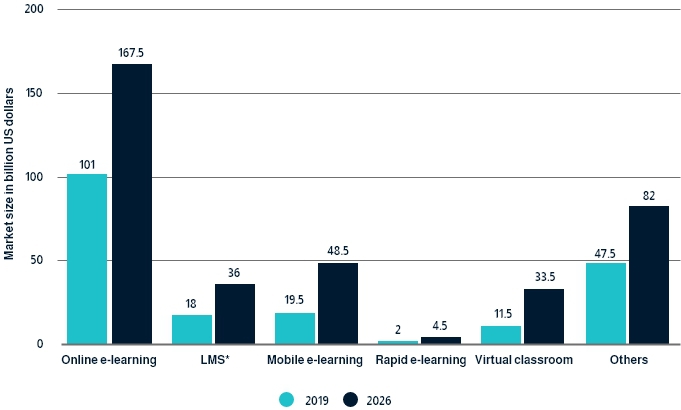
Size of the global e-learning market in 2019 and 2026 (in billion U.S. dollars)
The Rise In Access to Online Learning,“ Coursera Report
According to Coursera Impact Report, in 2016, approximately 21 million students enrolled in Coursera’s online courses, and this figure increased yearly by around 7 million over the following two years.
However, with the onset of the pandemic and the shift to remote working, there was a significant increase in new registrations, resulting in a three-fold increase.
In 2020, the number of new registrations climbed to 71 million, and by 2021, it reached an impressive 92 million.
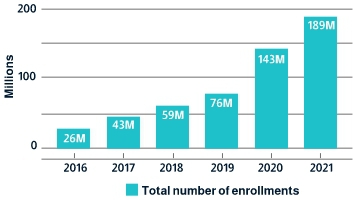

All of this demonstrates the growing demand for online learning and the high potential for businesses to reach a broader audience whether their goal is to educate remote employees or cater to global training needs.
Now, given the enticing and promising statistics about the growth of eLearning, let us explore eLearning localization and how investing in it can help both eLearning businesses and multinational companies reap significant benefits.
What Is eLearning Localization?
eLearning localization is the process of adapting eLearning content to suit the unique linguistic and cultural needs of target audiences in a way that enables the end-users to digest the information with maximum engagement and benefit.
This involves translating course materials into multiple languages, adapting content to suit cultural nuances, and ensuring compliance with local regulations and standards.
And when it comes to eLearning and training materials, there are a variety of content types and elements that typically need to be adapted for multilingual use and cross-cultural communication, from course videos and quizzes to graphics and design.
Let us have a look at some elements you should consider localizing in your eLearning materials.
- User Interface (layout, design, navigation buttons, etc.)
-
- Graphics & Images
- Audio & Video (voiceovers, subtitles, closed captions)
- Formatting Conventions (e.g. Date Formats)
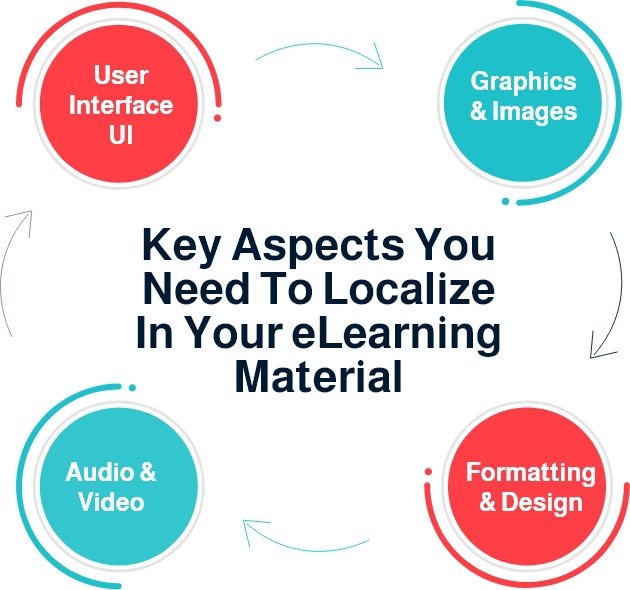
eLearning Translation vs. eLearning Localization
While translation is an essential component of eLearning localization, it is just one piece of the puzzle.
Without employing effective localization that considers the cultural context and nuances of your employees or target learners, you may fail to engage them with your training content, leading to poor retention and learning outcomes.
So why is that? Let us find out.
eLearning Translation |
eLearning Localization |
| Focuses primarily on the linguistic conversion of course content from one language to another. | Adapts eLearning content to fit not only the linguistic but also the cultural nuances and local standards of the target audience. |
| Does not account for multimedia adaptation | Adapts multimedia elements to ensure they are culturally appropriate and relevant to the target market, enhancing learner engagement and retention. |
| May not consider differences in learning styles and preferences among learners in different regions. | Considers learning style preferences (e.g. collaborative and independent learning styles) which can significantly impact the effectiveness of eLearning programs. |
| Creates an experience that sounds literally translated to local audiences. | Provides an authentically local experience to the audience for the best understanding of the materials. |
| Suitable for practical employee training (hard skills)
For example, a course on CV writing for International Companies |
Suitable for culture-specific training (e.g. soft skills)
For example, a workshop on business negotiation strategies |
5 Ways eLearning Localization Can Maximize Your Global Training Efforts
If you are seeking to train your global workforce or engage multilingual learners worldwide, localizing your training material can provide significant benefits, from improving engagement and employee retention to reducing costs and achieving greater international success.

1. Expanding Your Audience Base
If you are an eLearning platform and still considering localizing for more global markets, here’s a compelling reason to take the leap: 90% of learners prefer to receive their training materials in their native language.
And in this case, localizing your eLearning content gives you access to more potential audiences who are striving to find essential courses in their native language. According to Coursera’s report on the number of enrollments between 2016 and 2021 on the country level, the top 10 countries with the highest number of enrollments in online learning were the US, India, Mexico, Brazil, China, Canada, Russia, UK, Colombia, and Egypt.
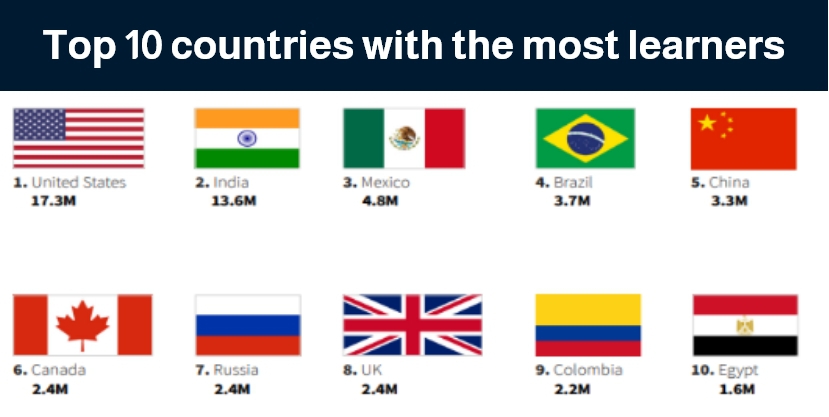
By localizing for language markets like Hindi, Arabic, Russian, and Chinese, you can double or even triple your audience number and address global multilingual training needs.
2. Boosting Retention Rate
eLearning localization has also proven to be significantly effective when it comes to boosting knowledge acquisition and engagement rates for employees and learners. People are more likely to retain information much easier when it is presented in a language that they are familiar with compared to foreign languages. This is because language is closely tied to a person’s cultural and social background, and familiarity with a language as well as cultural relevancy can help to improve the processing and comprehension of information. And this can only be achieved through localization. Research suggests that conducting a course in a foreign language can result in learning outcomes that are about half a standard deviation lower compared to the same course conducted in the learner’s native language. Not only does it lead to a significant drop in learners retention rates but it even adds an increased workload for them.
So why complicate your employees’ development journey by adding when you can make it easier for them to retain information and for you to achieve your training objectives?
3. Accelerating Employees’ Engagement & Productivity
71% of executives report that employee engagement is critical to organizational success. And companies with high employee engagement are 21% more profitable.

So how can eLearning localization boost your employee engagement?
eLearning localization can help to promote a sense of inclusivity and diversity in the workplace, which can lead to higher employee satisfaction and engagement. When employees feel that their needs and preferences are being valued and respected, they are more likely to be engaged in their job.
And engaged employees always outperform their peers that are not engaged.
Not only engagement but also localizing your training content can lead to a faster and more effective learning which in turn results in increased productivity among employees.
4. Reducing Injury & Fatality Rate Among Workers
In high-risk sectors like manufacturing, safety training can be a lifesaver for employees.
But if you are a multinational company that has foreign employees all over the world, localizing your online safety training can be the most effective way to promote workplace safety and support the well-being of employees wherever they are. So how is that? When employees do not fully understand safety instructions or procedures, they may be more likely to make mistakes that lead to serious accidents, injuries, or even fatalities at work. And this is very common among foreign workers. According to the Occupational Safety And Health Administration (OSHA), language barriers actually contribute to 25% of job-related accidents.
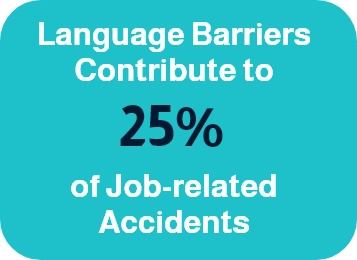
Can’t believe that?
In 2020, The Center for Construction Research and Training (CPWR) released a report that the fatality rate for Hispanic construction workers in the US was 41.6% higher than the rate for non-Hispanic workers, which again points out to the fact that language barriers can be a direct cause of accidents at work.

So, by localizing your eLearning courses and training programs, you reduce risks and ensure employee safety, regardless of the language they speak, their location, or cultural background.
Want to ensure that your
safety training is properly localized?
Download our eLearning Localization Checklist of Essential Do’s to make sure every important aspect of the localization process is covered!
5. Reducing Cost
Yes, you might know that online training or eLearning courses can be an easy way to reduce training costs per employee as it costs from one-third to one-fifth less than traditional classroom training.
But how can localizing these online courses help you to cut more costs?
- Localization lowers the costs associated with worker’s compensation claims and insurance premiums as they will be more aware of safety training provided in their native language.
- Localization ensures your employees understand and adhere to legal and regulatory requirements in different regions which helps to avoid costly fines, legal fees, and reputational damage.
- Localization reduces the costs associated with hiring interpreters or providing language training for employees.
5 Tips To Make Your eLearning Material Localization Friendly
1- Use Simple, Neutral language
Avoid using overly complex language, idioms, or cultural references as this makes it easier to add local flavors to each localized version of your eLearning model.
2- Use An Adaptable, Simple design
Avoid using a busy design and keep it adaptable to be easily localized for different languages and to reduce the cost and time required to create separate versions of your content for different languages.
3- Avoid Text On Images
Consider using separate text boxes or captions to provide context for images because it is easier to translate and localize compared to using text on images.
4- Provide Context
If there are essential cultural or regional references that your content uses, ensure that your content provides context for them because they might be unfamiliar to learners in different regions.
5- Hire Professionals For Localization
Hire industry-expert and native translators, voice-over artists, and localization specialists to ensure delivering the highest quality, effective training materials across different target languages and cultures
Laoret: Your eLearning localization partner
Laoret is a professional, ISO-certified provider of multilingual eLearning localization solutions offered across 120+ languages, with the highest quality, and the most competitive rates.
Our teams of native-speaking translation experts and localization specialists are always ready to empower your global workforce with eLearning courses that resonate with them on all levels, helping to boost inclusion, productivity, and overall performance.
Contact us today to learn more about our eLearning localization services and how we can help you maximize the benefits of your eLearning content in any language you desire!






